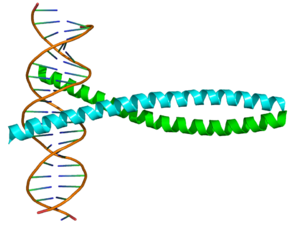
AP-1 (transcription factor)
Encyclopedia

Molecular biology
Molecular biology is the branch of biology that deals with the molecular basis of biological activity. This field overlaps with other areas of biology and chemistry, particularly genetics and biochemistry...
, the activator protein 1 (AP-1) is a transcription factor
Transcription factor
In molecular biology and genetics, a transcription factor is a protein that binds to specific DNA sequences, thereby controlling the flow of genetic information from DNA to mRNA...
which is a heterodimeric
Protein dimer
In biochemistry, a dimer is a macromolecular complex formed by two, usually non-covalently bound, macromolecules like proteins or nucleic acids...
protein composed of proteins belonging to the c-Fos
C-Fos
In the field of molecular biology and Genetics, c-Fos is a protein encoded by the FOS gene.-Structure and function:c-Fos is a cellular proto-oncogene belonging to the immediate early gene family of transcription factors. c-Fos has a leucine-zipper DNA binding domain, and a transactivation domain at...
, c-Jun
C-jun
c-Jun is the name of a gene and protein that, in combination with c-Fos, forms the AP-1 early response transcription factor. It was first identified as the Fos-binding protein p39 and only later rediscovered as the product of the c-jun gene. It is activated through double phosphorylation by the...
, ATF
Activating transcription factor
In molecular biology, activating transcription factor, ATF, is a class of AP-1 transcription factor dimers.Genes include ATF1, ATF2, ATF3, ATF4, ATF5, ATF6, and ATF7....
and JDP
Jun dimerization protein
Jun dimerization protein 2 is a protein that in humans is encoded by the JDP2 gene.The Jun dimerization protein is a member of the AP-1 family of transcription factors.-Interactions:...
families. It regulates gene expression
Gene expression
Gene expression is the process by which information from a gene is used in the synthesis of a functional gene product. These products are often proteins, but in non-protein coding genes such as ribosomal RNA , transfer RNA or small nuclear RNA genes, the product is a functional RNA...
in response to a variety of stimuli, including cytokines, growth factor
Growth factor
A growth factor is a naturally occurring substance capable of stimulating cellular growth, proliferation and cellular differentiation. Usually it is a protein or a steroid hormone. Growth factors are important for regulating a variety of cellular processes....
s, stress, and bacterial and viral infections. AP-1 in turn controls a number of cellular processes including differentiation
Cellular differentiation
In developmental biology, cellular differentiation is the process by which a less specialized cell becomes a more specialized cell type. Differentiation occurs numerous times during the development of a multicellular organism as the organism changes from a simple zygote to a complex system of...
, proliferation, and apoptosis
Apoptosis
Apoptosis is the process of programmed cell death that may occur in multicellular organisms. Biochemical events lead to characteristic cell changes and death. These changes include blebbing, cell shrinkage, nuclear fragmentation, chromatin condensation, and chromosomal DNA fragmentation...
.
AP-1 upregulates transcription of genes containing the TPA
12-O-Tetradecanoylphorbol-13-acetate
12-O-tetradecanoylphorbol-13-acetate , also commonly known as tetradecanoylphorbol acetate, tetradecanoyl phorbol acetate, and phorbol 12-myristate 13-acetate , is diester of phorbol and a potent tumor promoter often employed in biomedical research to activate the signal transduction enzyme protein...
DNA response element
Response element
Response elements are short sequences of DNA within a gene promoter region that are able to bind a specific transcription factor and regulate transcription of genes.-Examples:Examples of response elements include:*Hormone response element...
(TRE; 5'-TGAG/CTCA-3'). AP-1 binds to this DNA sequence via a basic amino acid region, while the dimeric structure is formed by a leucine zipper
Leucine zipper
A leucine zipper, aka leucine scissors, is a common three-dimensional structural motif in proteins. These motifs are usually found as part of a DNA-binding domain in various transcription factors, and are therefore involved in regulating gene expression...
.

